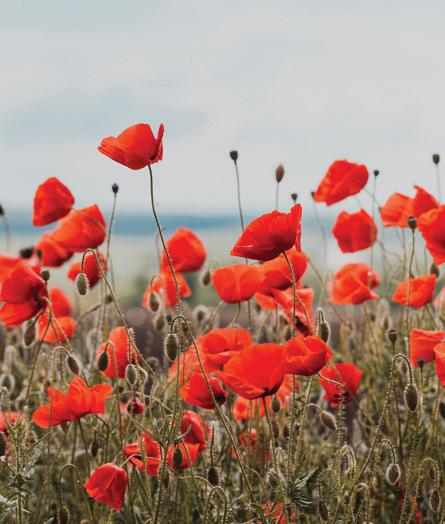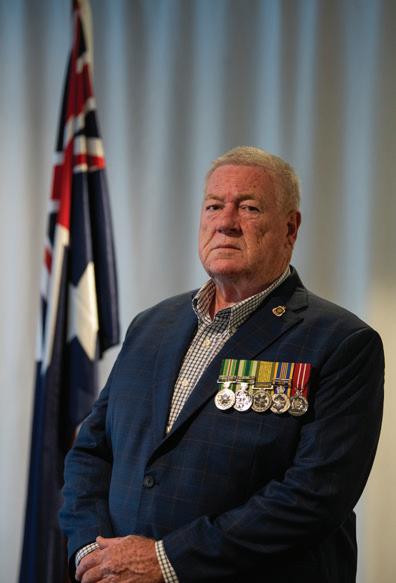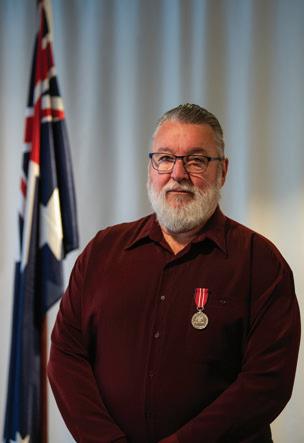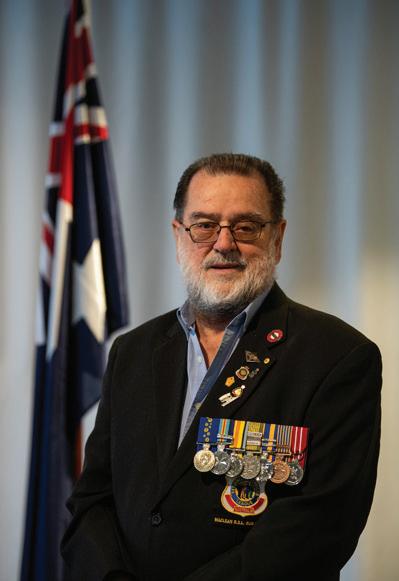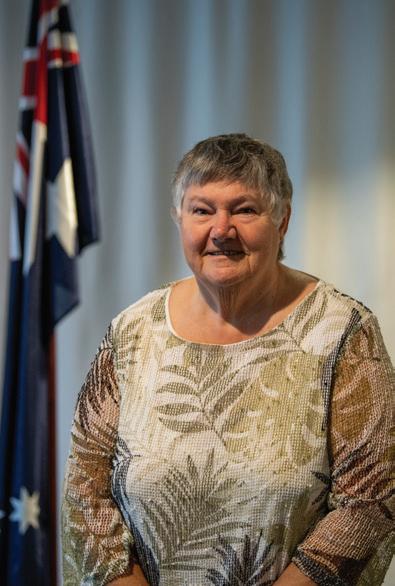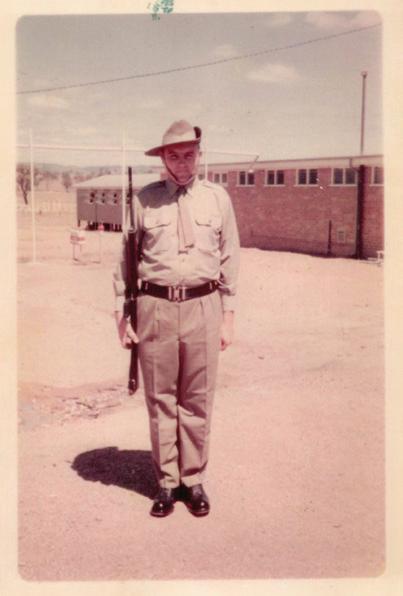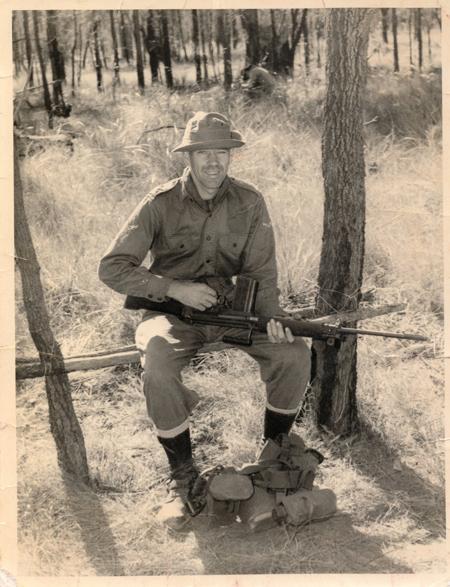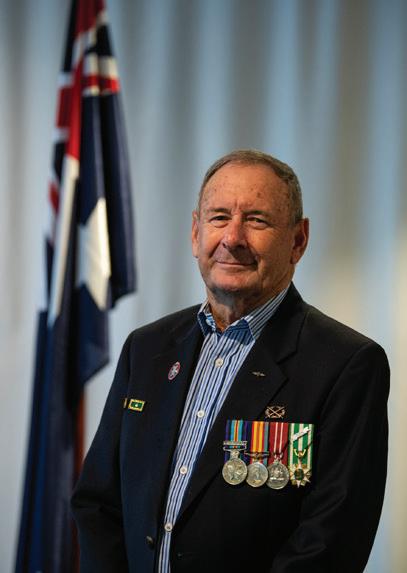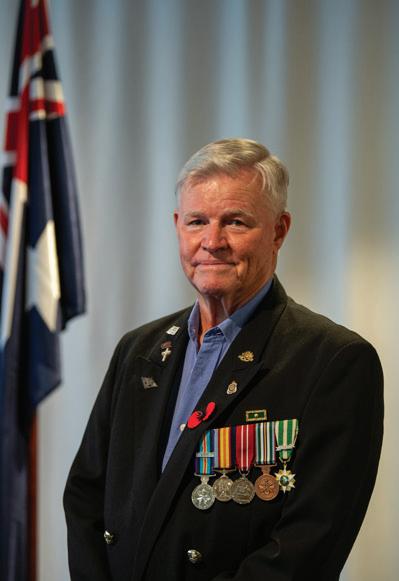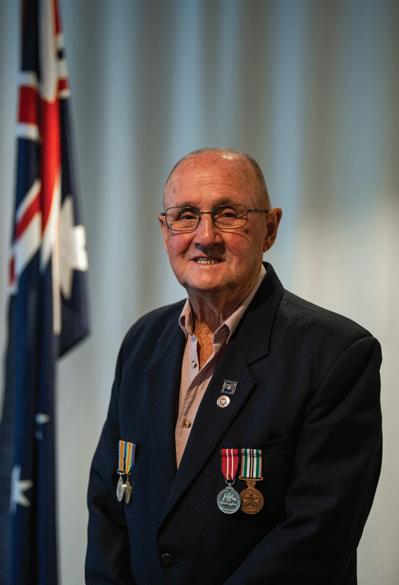Then and Now
An Exhibition of Service women and men of the Clarence Valley
This project brings together the personal stories and experiences of those who have served, offering a unique perspective on their lives both then and now. Each participant has shared not only their memories but also provided photographs from their time in service alongside a new portrait, reflecting the passage of time and the lasting impact of their service.
The aim of this project is to honour and preserve these stories for future generations. Through these contributions, we gain a deeper understanding of the sacrifices and dedication shown by those who served and the lives they have built since.
We are deeply grateful to all who took part, for your willingness to share your memories and for allowing us to capture your journeys through both words and images. Your stories are an invaluable part of our community’s history and we are honored to include them in this collection.
Thank you for being a part of this important project.
We acknowledge the Bundjalung, Gumbaynggirr and Yaegl people as the Traditional Owners of the land on which we live and work. We honour the First Nations peoples culture and connection to land, sea and community. We pay our respects to their Elders past, present and emerging.
My story is much like that of many other young men in the fifties. The war in South Korea had started and they were looking for volunteers to form, what they called K force to start an Australian Battalion to defend South Korea, with many other Nations from around the world being involved. This was something that appealed to me. However, being too young at the time, I was rejected.
So, I waited until I was 17 years old and I tried to enlist again in K Force. Once more I was rejected, I had to be 18 years old, but wait for it... the Regular Army accepted recruits at the age of 17 years. What was I waiting for? Acceptance from this avenue allowed me to enter the military. Mission accomplished!
After my basic training, I was transferred to supply & transport working at Randwick Barracks in Sydney, and during this time I turned 18 years old. By this time the military were calling for more volunteers to go over. Here was the opportunity I had been waiting for, nothing would stand in my way!! This time the volunteers who had joined in the 50’s could sign up for another 3 or 6 months or come home and be replaced by more volunteers. This battalion, by the way, was 3RAR better known as, Old Faithful. I was one of the men who replaced someone who wished to come home.
A lot of men who joined in the 50’s were still in the services or had been discharged after the WWII. I met one digger over there, who had signed up 3 times, I asked him why. His reply was “I have nothing to go home to.” Altogether I spent 12 months in Korea & 2 months in Japan with this battalion. The entire engagement of 3 battalion was for the whole period of the war from 1950 until the peace talks started in 1953. Thus the departure of the whole battalion commenced with the sailing from Pusan South Korea on the “New Australia” passenger ship in 1954. Arriving in Sydney we marched through the streets of the city to a very welcome home coming.
Brian Walter Thomas - Continued...
Peter Prowse - Army PTE
Conscripted in 1968
Retired from service in 1970
Peter Prowse - Continued...
My name is Peter ’Mick’ Prowse. My wife and I have lived on the Lower Clarence for the past 45 years.
On the 1st May 1968 I joined the Army as a conscripted National Serviceman (which I had no qualms about). Following Recruit and Infantry Training in NSW, I was posted as a private soldier to the Australian Reinforcement Unit (ARU) at Nui Dat, South Vietnam arriving there on 5th January 1969.
The following are extracts from letters I sent to my parents between February and May 1969.
18-2-69 - Mum & Dad & Kids.
Hello dere! How is every thing at home? At the moment our company is out on an operation near Baria. It’s not too far from Nui Dat, we are out here in case the nogs attack one of the towns in this vicinity. We have tanks & APC’s with us & most of our patrolling is done with the APC’s... Did I tell you I’m the 6PL Looy’s batman. It’s a pretty good job. I do his brews (coffee & tea that is) & act as protection for him in the field. As I have to stick with the Looy I get to see a lot more than the blokes in the sections. I like the job & I’m going to see if I can stick with it........
26-2-69 - Dear Mum & Dad,
... Last Sunday morning we joined in a battle at Baria just before dawn. The tanks & APC’s engaged the enemy & at first light we did a sweep through the outskirts of the town. Our platoon captured one wounded VC and got a couple of others. The rest of them had gone back into the hills. These blokes were pretty well equipped, they left behind a hell of a lot of arms & equipment. We didn’t take any casulties but the ARVN post they hit was a mess. It was a recruit training post.
Well so far that is about the most interesting thing that has happened.
1/4/69 - 6PL B coy 9RAR Dear Mum, Dad & sisters,
... We are still out in the jungle in Long Binh province ... The last couple of days we have been walking our guts out up & down creeks
and hills. This op we didn’t have much contact with the enemy, found a couple of camps ... We watched an air strike on one camp & when we moved in found the place pretty well shot-up. The yank pilots certainly do a spot-on job. ... So far this op I’ve been carrying the no2 set, acting as reserve sig. Gawd that bloody radio gets heavy when we’re pushing through the scrub. It’s real jungle up this way, you’re lucky to be able to see 20 feet in front of you. Yesterday our lead scout saw something move in front of him and let go a burst at it, turned out to be a herd of wild pigs, they went charging straight down the line through the platoon & Coy HQ, blokes & pigs going everywhere. By the way, Fred the scout didn’t hit any of them.
Stephen Walton- Army Major
Enlisted in 1977
Retired from service in 2004

I served in the Army Reserve from 1977 to 2004 as a member of the Australian Army Psychology Corps. I joined 12 Psychology Unit as a Private and progressed through the ranks to become a WO2. In 1992 I qualified as a psychologist and was commissioned a Lieutenant in the Corps. In 12 Psych we performed our specialist role and also took our soldiering seriously. As training officer with Weddy my training NCO and Donny our Infantry Corps advisor we ran annual platoon level exercises with the troops. We worked with a great team of soldiers who still keep in touch to this day. Posted on promotion to student counsellor at Sydney University Regiment, the experience I gained at 12 Psych made for an easy transition to ARES Squadron Commander in 1 Psychology Unit (ARA) followed by deployments to Bougainville on OP Bel-Isi II and to the Middle East on OP Catalyst. I went to school with Weddy. We are best mates and over the years we gained something of a reputation for our “enthusiasm”. When we were both posted to 1 Psych I asked the CO who knew us well if we might be deployed together to which he replied, “what, you two… together?” So while I was in Kuwait, Weddy was in Kyrgyzstan, and so on and so on. A disappointment but great days nonetheless.

Mark Burr - Army Craftsman
I enlisted in the Army straight after completing Year 10 at school to do a mechanics apprenticeship. I was sent to the Army Apprentices School at Balcombe, Victoria. I was there for 2 years doing the course before being posted to 2 Base Workshops at Moorebank NSW. I worked there for 2 years then went to 2 Calvary Unit at Holsworthy. After this I was transferred to the Singleton Workshop Platoon where I stayed until my discharge after 9 years of service. It was a great profession and I made some great mates who remain good friends to this day, even if we don’t see each other often since we are scattered all over Australia. I worked on all types of vehicles from cars to trucks and tanks, which gave me a great start in civilian life.
Trevor Plymin - Navy CPO
Enlisted in 1966
Retired from service in 1986
In my 20 years in the Navy I got to see a lot of the world. I made friends that are still current today. My longest trip was nine months on the HMAS Stuart in the far East. I was also on the HMAS Sydney III and went to Vietnam on three occasions.
Conscripted in 1965
Retired from service in 1967
Robert McFarlane OAM - Army Gunner
After the Australian government passed the National Service Bill into law, the NSW lottery office was appointed to conduct a ballot of the birth dates for the first six months of 1965 and subsequent dates in six month batches.
Each Australian male whose twentieth birthday fell in that period was required to register for National Service. Number 158 rolled out of the barrel, this number coincided with my birth date and so I began my 2 years National Service. The first year was taken up with recruit training, corp training and specialist training. I was posted to 1st Field Regiment Royal Australian Artillery as a gunner and then to North
Head School of Artillery to train as a forward observation signaller. At the conclusion of the first year my unit was notified for active service to South Vietnam.
My unit 103 field battery, 1st Field Regiment flew out of Richmond RAAF base at midnight on a cold May evening 1966, on board a Qantas 707, bound for South Vietnam. We arrived in Saigon on a very hot dry day and as we looked out from our plane we saw a lot of military aircraft and a lot of local people wearing black loose fitting pyjamas. We had been told at the Jungle Warfare Training Centre, Canungra that all Viet Cong wore black pyjamas. You can understand our concern that everywhere we looked there were people in black, we were relieved to learn that most Vietnamese wore this dress and they were not necessarily our enemy. After 2 weeks of acclimatisation we moved to Nui Dat to begin our year of intense operations in Phouc Tuy Province.
As a forward observation signaller my job was to patrol with my allotted infantry unit which was D Company 5 RAR and to call in artillery support when required.
The year went quickly as we were constantly patrolling throughout the province. The major battle of Long Tan proved the worth of artillery and the 18 guns of 1st Field Regiment played a vital role in that battle, as well as the excellent training of our infantry soldiers. I witnessed the best and the worst of man’s inhumanity to man and was relieved to return home to Australia in May 1967.
Robert McFarlane OAM - Continued...
Don Freeman - Army Colonel
Enlisted in 1972
Retired from service in 2018
Don began his military career as an Army Electronics Technician Apprentice, arriving at the Army Apprentices School in Victoria on his fifteenth birthday in January 1973. He was commissioned as a Second Lieutenant in 1978 after graduating from the Officer Cadet School, Portsea, and transitioned from full-time service on 30 June 2010, finally discharging in January 2018.
Don Freeman - Continued...
During his career, Don undertook a variety of field training and representative appointments. He served on exchange with the US Army at Fort Gordon, Georgia, where he was a member of the US Army Tactics and Doctrine Training Team, and participated in deployments to Panama, Honduras, Japan, Germany and South Korea. For his service, he was awarded the United States Meritorious Service Medal with Oak Leaf.
Don was appointed Commanding Officer of the 8th Signal Regiment, attended Joint Services Staff College, and served as Deputy Director of Military Strategy in Defence Headquarters, earning the Chief of Defence Force Commendation for his work. He also attended the Asia Pacific Security Course in Japan.
In 2000, Don deployed to East Timor as Force Communications Officer for the United Nations Transitional Authority East Timor (UNTAET). During this deployment, he led a small party of UN Peacekeepers to the Falantil-controlled area of Aileu, where they were briefly taken hostage. Through negotiation, the situation was resolved, and Don was awarded the Force Commander’s Commendation.
Upon his return to Australia, Don was promoted to Colonel and served as Director of Command-and-Control Information Systems at Defence Headquarters in Canberra. He then attended the Pakistan National Defence University, living in Islamabad for over a year with his wife, Gabriella. After returning to Australia, Don served in Future Land Warfare Branch and as Defence Attaché to Singapore and Brunei for three years.
Don and Gabriella settled in Ashby in mid-2010, where Don transitioned from full-time service. He earned several qualifications during his career, including Masters of Science and Arts, and various diplomas in Strategic Studies, Management, Telecommunications and Counter-Terrorism. They continue to enjoy life in Ashby and the Clarence region.
Gabriella Freeman - Army Private
Enlisted in 1976
Retired from service in 1979
At 19, I craved adventure and felt stuck in my job. One day in 1976, I saw an Army recruitment van at Chadstone Shopping Centre, advertising training, travel and housing benefits. I signed up on the spot, eager for a change. My enlistment took me to Sydney for Women’s Royal Australian Army Corps (WRAAC) training. Though I hoped to join the Signals Corps, I was initially assigned to the Ordnance Corps. Refusing to settle, I stood up for my preference and was finally posted to the School of Signals in Melbourne—ironically, only an hour from home.
During a snow weekend at Mount Baw Baw, I met Don, a fellow Signaller. We hit it off immediately and got engaged just four days later. Military regulations made dating tricky, so we soon moved into a house in Greensborough with a friend. When Don was accepted into Officer Cadet training, I was thrilled for him, but the Commandant demanded I sign a letter resigning from the Army upon Don’s graduation. Though it was a difficult decision, I agreed, and I left the Army in January 1979. We were married a month later, in February. Leaving the Army was not what I had envisioned for myself, as I had originally joined to see the world. However, supporting Don in his military career opened the doors to experiences beyond what I could have imagined. While Don climbed the ranks, I became the constant in our household, adapting to each new city, country and challenge that came our way. I found joy in the friendships I built, the places we explored and the life we built together, even though my own military ambitions were set aside.
Don and I built a wonderful life together, raising two children, Bianca and Michael, and later welcoming two grandchildren, Lucinda and Samuel. We lived in several cities across Australia and enjoyed international postings in the USA, Pakistan, and Singapore. My initial desire for travel was more than fulfilled, as we embraced each new opportunity to explore the world and immerse ourselves in new cultures.
In 2010, Don transitioned from full-time service, and we settled in Ashby, where we now enjoy the peaceful lifestyle of the Clarence Valley and its surrounds. Looking back, the journey was not the one I had initially planned, but it led to a life full of adventure, family and fulfillment.
Gabriella Freeman - Continued...
Edward O’Neill - Navy
Conscripted in 1956
Retired from service in 1956
Edward O’Neill - Continued...
In June 1956 I and 10 other NASHOS, were put on the Spirit of Progress in Melbourne and arrived in Sydney. We travelled via the John Cahill Freeway, the first freeway built in Australia, to HMAS Penguin where we completed six weeks initial training and saw HMAS Voyager doing sea trials whilst we were doing rifle training at Long Bay.
The group was then placed in various categories such as Sick Berth Attendants and put on ships including the HMAS Sydney. I was placed on the HMAS Melbourne with planes such as Gannets flying exercises over Jervis Bay. Just prior to that, Sea Venom planes had been removed from the Aircraft Carrier with its angled flight deck due to two of the planes being lost overboard during take off and landing exercises. Two crew of one of the planes were taken to the seabed whilst still in the aircraft.
I was given duties such as evening watch in the ships hanger. After ten days, I was removed from the ship and placed at HMAS Albatross where I was given further training and miscellaneous duties until discharged at the end of November.
Conscripted in 1966
Retired from service in 1968
Graham Guile - Army Craftsman
Graham Guile - Continued...
I was a 2-year conscript from 1966 to 1968. After 10 weeks Basic Training at Singleton, I was hosted No 1 General Base Workshops R.A.E.M.E at Bulimba in Brisbane.
From Brisbane, I was dispatched No 2 Base Workshop in Sydney to install Land Rover and trailer with mobile workshop equipment to go to Vietnam.
I was sent back to Brisbane and told I was being re-hosted for Port Moresby in Papua New Guinea for the rest of my time in the army.
Part of my job in RAEME was to train native army apprentices in the trade of fitting and machining in the Murray Barracks Workshop.
There were 2 RAAF Caribous stationed in Port Moresby and the army used them to do a 3 week tour into 5 small towns in the Highlands of Pauna New Guinea.
The small towns are remote and one place called Wabag the up hill airstrip was the same height as Mount Kosciuszko in Australia.
My entry into the RAN was on a whim, as I was unhappy living inland after spending most of my life on the coast. I took an oath in Brisbane and boarded the Sydney train on 26th July 1963, heading to HMAS Cerberus, where some of the best years of my life began.
Basic training moulded us into sailors, taking kids from all over Australia and transforming us in 12 weeks. My first posting was to HMAS Voyager, a Daring Class destroyer, but it wasn’t until January 1964 that I felt her power at sea, arriving in Sydney just before Australia Day.
Tragically, Voyager was bisected by HMAS Melbourne on 10th February 1964, resulting in the loss of 82 men. After Survivor’s Leave and rehab at HMAS Penguin, I was posted to HMAS Sydney, a converted aircraft carrier. We prepared her for a trial run to Borneo, Singapore and Malaysia, carrying essential equipment. This 6-week trip took us through rough weather in the Great Australian Bight, where I experienced my first true storm at sea.
Ian McKay - Continued...
I then returned to Cerberus for Electronic Training and was later posted to HMAS Vendetta in July 1965. Vendetta was a ‘happy’ ship under Commander David Leach, the finest man I ever served under. Despite our ranks, we remained friends even after his retirement as Chief of the Navy.
My time on Vendetta deepened my affinity for Daring Class ships, fearsome in full flight, capable of 40 knots, and equipped with air conditioning and bunk beds—a luxury compared to hammocks.
In 1967, I was involved in building and commissioning HMAS Aitape, the first Attack Class patrol boat, destined for Papua New Guinea. We trained PNG sailors to take over the boats by 1975 and conducted Fisheries Patrols and Coastwatcher service reconstitution, vital since the late 1930s.
Returning to Australia in September 1969, I spent my final years at the Naval Transmitting Station, Belconnen, keeping the RAN ‘on the air’ 24/7 and assisting during significant events, including the moon landing. My RAN career, ending in July 1972, was filled with hard work, global experiences, new skills, and the camaraderie of dependable men—time well spent.
Keith Sneesby - Army Lance Corporal
Unit 41st Infantry Battalion RNSWR
Enlisted as a private soldier in an infantry section. Promoted to Lance Corporal and was made A section leader.
During this training period, I completed my national service obligations.
I also participated in the presentation of the Queen’s and regimental colours ceremony to the battalion.
The photo shows me at the end of a training exercise in the mountains at Singleton about to make a patrol report for my section.
Ken Ford - Army Tradesman
Enlisted in 1962
Retired from service in 1971
I joined the Regular Army in 1962, for 9yrs. After training as a Soldier/ Tradesman I was posted to the Corps of Royal Australian Engineers, 7Fd Sqn in Enoggera Qld. With the Introduction of National Service spent a lot of time at Canungra and Shoal Water Bay developing training areas.
Posted to Vietnam in early 1968, to 1 Fd Sqn, we worked in small teams attached to 2 & 4 RAR Battalions in mine clearance, booby trap and tunnel search roles, plus the Battles around FSB Coral.
In 1969 back to Enoggera training new troops, 1970 returned to Vietnam in a mine clearing role.
Discharged from the Army in Jan 71.
I joined the Regular Army in October 1982 and after completing my service there continued service in the Army Reserve or the part time Army as it is referred to these days. In the army I served as a rifleman, machine gunner and mortarman in various infantry units as I moved around a little before returning to the Clarence Valley, where I grew up.
After a few years in infantry I transferred to the 21st Regt. Royal Australian Engineers where I completed my 16 years service as what is known as a “Vegie” or Field Engineer having served my time as a Sapper, the lowest rank in the Engineers. Ambition has never been
Peter Hay - Continued...
my middle name. The Army appeared to think that I enjoyed finishing concrete as I spent most of my later service in this role. I can assure you that I did not enjoy this work, but the Army knows best.
One occasion that comes to mind is when my unit was tasked in the building of a wharf at Goat Island in Sydney Harbour. We had two Sappers in our unit, who, whilst being very good tradesmen were useless as soldiers. One evening the officers decided to turn us loose on the residents of Sydney and even supplied a water taxi on the condition that we were all back on the island by 2200 hrs and in a fit state to commence work the following day. However this pair of larrikins decided that they did not wish to pay the $5.00 fare and were able to procure a canoe which they paddled to Circular Quay, breaking several laws and at great risk to themselves. For this they received severe reprimands and given extra piquet duties for the remainder of our stay on the island.
Another incident was when we were posted to the Proving & Experimental Establishment at Port Wakefield in South Australia. We were working in conjunction with another unit building very large warehouses. The unit that we were working with was Brisbane based, but had their deployment increased by a further two months. This led one of the brickies to sort out a pile of same coloured bricks which he used to spell out in large capitals letters “FTA”. TA means The Army and you can guess what the “F” stands for. His efforts earned with a fine, demotion and he had to rebuild the wall in his own time. I doubt if he did that again.
My time in the Army was well spent and built my character (for the better, I hope). Without my service I would probably not have lasted my twenty years as a Prison Officer.
Conscripted in 1967
Retired from service in 1969
Ross Carl - Army Gunner
Ross Carl - Continued...
I was conscripted into the army in July 1967. After basic training at Puckapunyal New South Wales, I was assigned to the artillery as a Signaller with the rank of Gunner. Training was at North Head, Sydney, New South Wales. Once training was completed I was assigned to the 12th Field Regiment, Head Quarters Battery at Holsworthy, New South Wales.
12th Field Regiment was assigned to Vietnam in 1968. I undertook Jungle Training at Canungra in Queensland before departing Australia in the Autumn of 1968. I was in the country approximately two weeks before I was assigned to ‘Fire Support Base Coral and Balmoral,’ between 12th May-6th June 1968, as a Signaller. Our unit received a Unit Citation for Gallantry for their participation in Coral and Balmoral.
The balance of my time in Vietnam was spent doing general duties at Nui Dat, with the occasional trip outside Nui Dat precinct with the Engineers to rebuild structures for the South Vietnamese people. I returned to Australia in March 1969 and spent the remainder of my service at Long Bay, Sydney New South Wales, Rifle Range, before my discharge from the service in July 1969.
William Baker - Army Sapper
Conscripted in 1967
Retired from service in 1969
We sailed from Sydney in late December 1968, calling into Townsville then Darwin and onto Vietnam. The ship was alongside the Pier for a number of days whilst unloading and loading damaged Army equipment.
My position on ship was 1st Mates Watch. Positioned on the bridge either steering or on watch from 4am to 8am and 4pm to 8pm. The Bosun was injured whilst unloading and I was assigned the task of Mug-Pilot. A Mug-Pilot brings the ship into Port under the commands of the skipper. We sailed onto the Philippines (Subic Bay) to load more ordinance. From there to Labuan - Townsville - Sydney in late March 1969.
Kevin McGrath - Army Corporal
Conscripted in 1965
Retired from service in 1967
I was conscripted for 2 years National Service training in 1965 and arrived in Kapooka Army Base on the 30th June. Recruit training was a real shock to the system. After 10 weeks, I was transferred to 1 Company Transport Ingelburn for Driver Training. This took about 4 months, including Driver Instruction, Map Reading, Mechanics and 3 weeks at Richmond Air Base for Air Dispatch training. After training was completed, I received my Army Licence G11 and was then posted to 86 Transport Platoon 25 Company General Transport in Puckapunyal, Victoria.
Driving International Mrk 3 trucks, Studebaker 6 x 6 and Landrovers, general transport included moving 7 Battalion Troops, shifting ammunition and general carrying. After 6 months with 86 Transport, I was posted to a new unit – R.A.A.S.C. Centre Detachment at Bonegilla, Victoria for Driver Training of National Servicemen. This unit was made up from 1st Call Up National Servicemen and regular
Kevin McGrath - Continued...
army members of the Royal Australian Army Service Corps, from Officers down to Corporals.
I was promoted to Corporal for the detachment but was the only ‘Nasho’ in the platoon, which consisted of 1 Lieutenant, 2 Sergeants and 4 Corporals. The training was relatIvely easy as most of the men could drive but there were a few twenty-year olds who had never driven before which was hard to believe at the time.
We trained around the Snowy Mountain area, including exercises in the Kosciuszko National Park. It snowed many times and was very cold sleeping in ‘hutchies’ and wearing clothes designed for jungle training. The only saving grace was our combat jackets and thick coats.
At Bonegilla Detachment, we had 4 platoons of trainee drivers for each intake, which consisted of 40 or 50 trainees for each Platoon. I was there for three intakes over 12 months.
When I left the army in 1967, I can’t say I missed it too much –certainly not those cold nights in the Snowy. However, the one thing I did miss were my mates from both the regulars and National Service Staff, many of whom became lifelong friends and with whom I am still in contact today.
Thank you...
